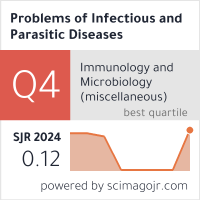PREVALENCE OF NEISSERIA GONORRHOEAE AND MYCOPLASMA GENITALIUM IN BULGARIAN POPULATION FROM SOFIA MUNICIPALITY OF REPRODUCTIVE AGE, 2018-2019
DOI:
https://doi.org/10.58395/pipd.v49i2.56Keywords:
Neisseria gonorrhoeae, Mycoplasma genitalium, prevalence, risk factors, BulgariaAbstract
Background: N. gonorrhoeae and M. genitalium infections remain public health concern due to emerging antimicrobial resistance which compromise effective treatment and infection prevention and control.
Objective: To estimate the prevalence for N. gonorrhoeae and M. genitalium infections and identify demographic and sexual behavioral risk factors in Bulgarian population of reproductive age from Sofia municipality.
Material and methods: Participants were sexually active 443 men and 198 women aged 18-49 years. They answered questionnaires on sexual behavior and provided samples for N. gonorrhoeae and M. genitalium testing.
Results: The prevalence of N. gonorrhoeae infection was 3.28% (21/641) and with M. genitalium infection it was 2.49% (16/641). For both infections the presence of urogenital symptoms was associated with greater risk of being infected. Among gonococcal infections an increased number of lifetime partners and partners during the last 6 months, previously diagnosed STIs and use of contraception other than condoms were associated risk factors.
Conclusions: The prevalence of N. gonorrhoeae and M. genitalium infections in Bulgarian population of reproductive age from Sofia municipality was relatively low but due to significant disease burden data on prevalence and identified risk factors should help the development of future control strategies.
Downloads
References
Rowley J, Vander Hoorn S, Korenromp E, Low N, Unemo M, Abu-Raddad LJ, et al. Global and regional estimates of the prevalence and incidence of four curable sexually transmitted infections in 2016. WHO Bull June. 2019;
Jensen JS, Cusini M, Gomberg M, Moi H. 2016 European guideline on Mycoplasma genitalium infections. J Eur Acad Dermatology Venereol. 2016;30(10):1650–6.
Taylor-Robinson D, Jensen JS. Mycoplasma genitalium: From chrysalis to multicolored butterfly. Clin Microbiol Rev. 2011;
Unemo M, Jensen JS. Antimicrobial-resistant sexually transmitted infections: gonorrhoea and Mycoplasma genitalium. Nat Rev Urol. 2017;14(3):139.
Ministry of Health (Bulgaria). Ordinance No 21 of 2005 on the procedure for registration, notification and reporting of communicable diseases, Amd. DV. vol.52/08.07.2011, Amd. and Suppl. DV. vol.56/08.07.2014, Amd. and Suppl. DV. vol.5/15.01.2019. Darzhaven vestnik; 2005.
Satterwhite CL, Torrone E, Meites E, Dunne EF, Mahajan R, Ocfemia MCB, et al. Sexually transmitted infections among US women and men: prevalence and incidence estimates, 2008. Sex Transm Dis. 2013;40(3):187–93.
Raykova V. Detection of common bacterial causes of urethritis in symptomatic men at the STD laboratory of MU-Sofia by microscopy, culture and NAAT. Scr Sci Medica. 2019;51(3):62–7.
Philipova I, Kouzmanov A, Ivanova Z, Kantardjiev V. Mycoplasma genitalium: prevalence and clinical significance in Sofia, Bulgaria. Probl Inf Parasit Dis. 2017;45(2):25–7.
Ouzounova-Raykova V V, Markovska R, Mizgova G, Mitov IG. Detection of the sexually transmissible genital mycoplasmas by polymerase chain reaction in women. Sex Health. 2011;8(3):445–6.
Rumyantseva T, Golparian D, Nilsson CS, Johansson E, Falk M, Fredlund H, et al. Evaluation of the new AmpliSens multiplex real-time PCR assay for simultaneous detection of Neisseria gonorrhoeae, Chlamydia trachomatis, Mycoplasma genitalium, and Trichomonas vaginalis. APMIS. 2015;
Goire N, Nissen MD, LeCornec GM, Sloots TP, Whiley DM. A duplex Neisseria gonorrhoeae real-time polymerase chain reaction assay targeting the gonococcal porA pseudogene and multicopy opa genes. Diagn Microbiol Infect Dis. 2008;61(1):6–12.
Jensen JS, Borre MB, Dohn B. Detection of Mycoplasma genitalium by PCR amplification of the 16S rRNA gene. J Clin Microbiol. 2003;
Altman DG. Practical statistics for medical research. CRC press; 1990.
Sheskin DJ. Handbook of parametric and nonparametric statistical procedures. crc Press; 2020.
European Centre for Disease Prevention and Control. Gonorrhoea - Annual Epidemiological Report for 2018. Stockholm; 2019.
Fenton KA, Lowndes CM. Recent trends in the epidemiology of sexually transmitted infections in the European Union. Sex Transm Infect. 2004;80(4):255–63.
Marcus U, Ort J, Grenz M, Eckstein K, Wirtz K, Wille A. Risk factors for HIV and STI diagnosis in a community-based HIV/STI testing and counselling site for men having sex with men (MSM) in a large German city in 2011–2012. BMC Infect Dis. 2015;15(1):14.
Cole MJ, Spiteri G, Town K, Unemo M, Hoffmann S, Chisholm SA, et al. Risk factors for antimicrobial-resistant Neisseria gonorrhoeae in Europe. Sex Transm Dis. 2014;41(12):723–9.
de Vega IF, Baliu-Piqué C, Mestres JB, Gómez AV, Vallés X, Gibert MA. Risk factors for antimicrobial-resistant Neisseria gonorrhoeae and characteristics of patients infected with gonorrhea. Enferm Infecc Microbiol Clin. 2018;36(3):165–8.
Edouard S, Tissot‐Dupont H, Dubourg G, Bernard A, Fournier P, Ravaux I, et al. Mycoplasma genitalium, an agent of reemerging sexually transmitted infections. Apmis. 2017;125(10):916–20.
Baumann L, Cina M, Egli-Gany D, Goutaki M, Halbeisen FS, Lohrer G-R, et al. Prevalence of Mycoplasma genitalium in different population groups: systematic review andmeta-analysis. Sex Transm Infect. 2018;94(4):255–62.
Christofolini DM, Leuzzi L, Mafra FA, Rodart I, Kayaki EA, Bianco B, et al. Prevalence of cases of Mycoplasma hominis, Mycoplasma genitalium, Ureaplasma urealyticum and Chlamydia trachomatis in women with no gynecologic complaints. Reprod Med Biol. 2012;11(4):201–5.
Hancock EB, Manhart LE, Nelson SJ, Kerani R, Wroblewski JKH, Totten PA. Comprehensive assessment of sociodemographic and behavioral risk factors for Mycoplasma genitalium infection in women. Sex Transm Dis [Internet]. 2010 Dec;37(12):777–83. Available from: https://pubmed.ncbi.nlm.nih.gov/20679963
Downloads
Published
Issue
Section
License
Copyright (c) 2021 Ivva Philipova, Viktoryia Levterova, Ivan Simeonovski, Zoya Ivanova, Liubomira Boyanova, Todor Kantardjiev (Author)

This work is licensed under a Creative Commons Attribution 4.0 International License.






